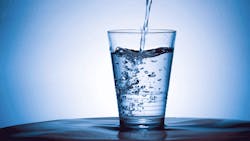AIHce 2013: Investigating Surface Spills in the Fracking Industry
The process of extracting gas through hydraulic fracturing, or “fracking,” has raised questions of potential health and safety implications, including the possibility of groundwater contamination. At the American Industrial Hygiene Conference and Expo (AIHce) in Montreal, Heather Avens, Ph.D., a health scientist with ChemRisk LLC, shared what she and her colleagues uncovered about surface spills in hydraulic fracturing.
“Hydraulic fracturing is technology that relies on high-pressure injection of water mixed with a combination of chemicals and sand formulated to physically fracture subsurface reservoirs for the purpose of extracting oil and gas,” Avens explained. Hydraulic fracturing may takes place anywhere from several hundred feet to several miles below the surface.
The fracking industry is a controversial one, with some safety and environmental stakeholders pointing to concerns surrounding the possible contamination of drinking water, which they say might occur if methane or chemicals leak or if surface spills contaminate the groundwater. Currently, there is a lack of scientific studies examining these potential contamination routes.
Avens and her colleagues set out to better understand surface spills associated with hydraulic fracturing activities. Their research focused on surface spills and on potential contamination from benzene, toluene, ethylbenzene and xylene (BTEX). The study was further confined to Weld County, Colo., which has the highest density of drilling well sites in the United States
According to the Denver Post, Avens told AIHce attendees, 343 new spills occurred in Colorado in 2011, with 58 impacting groundwater, particularly in Weld County. Furthermore, benzene spilled at concentrations exceeding state standards by as much as 320 times.
Studying Spills
Avens and colleagues examined data from the Colorado Oil and Gas Conservation Commission (COGCC), which requires spills greater than 5 barrels be self reported, and spanned the yearlong period between July 1, 2010, and July 2, 2011.
Key findings include:
- During this period, 77 surface spills that had groundwater impact were recorded in Weld County, which had about 18,000 active wells.
- Approximately 0.4 percent of active wells in the county experienced surface spills during the study period.
- Of those spills that included reporting data, between one and 28 barrels of produced hydraulic fracturing water were spilled, with an average of seven barrels.
- The average area of a spill was 197m3 and the average depth was 2 meters.
- Tank battery systems represented a major point of origin for spills.
- Equipment failure, including corrosion, was a common cause of a spill. Only three spills were reported as human error.
- BTEX concentrations were significantly lower just outside the excavation area compared to inside excavated area.
- BTEX concentrations decreased quickly as the distance from a spill increased.
Avens pointed out that the research addresses concentrations at the spill site, not at any downstream drinking water receptor, where concentrations are assumed to be much lower. She added that many hydraulic fracturing sites appear to be unmanned, where equipment failure and leaks could occur without immediate notification.
The researchers offered several recommendations based on their findings, including:
- Well operators should conduct comprehensive chemical risk analyses to understand the risks of surface spills.
- Important factors such as water table depth must be carefully considered.
- Equipment safety systems should be carefully considered and enhanced as needed, especially for sites without a consistent human presence.
- Well operators should more effectively communicate safety procedures and risk.
The research, which Avens said is believed to be the first peer-reviewed article focusing on surface spills associated with hydraulic fracturing, was published in Journal of the Air & Waste Management Association.
About the Author

Laura Walter
Laura Walter was formerly senior editor of EHS Today. She is a subject matter expert in EHS compliance and government issues and has covered a variety of topics relating to occupational safety and health. Her writing has earned awards from the American Society of Business Publication Editors (ASBPE), the Trade Association Business Publications International (TABPI) and APEX Awards for Publication Excellence. Her debut novel, Body of Stars (Dutton) was published in 2021.
